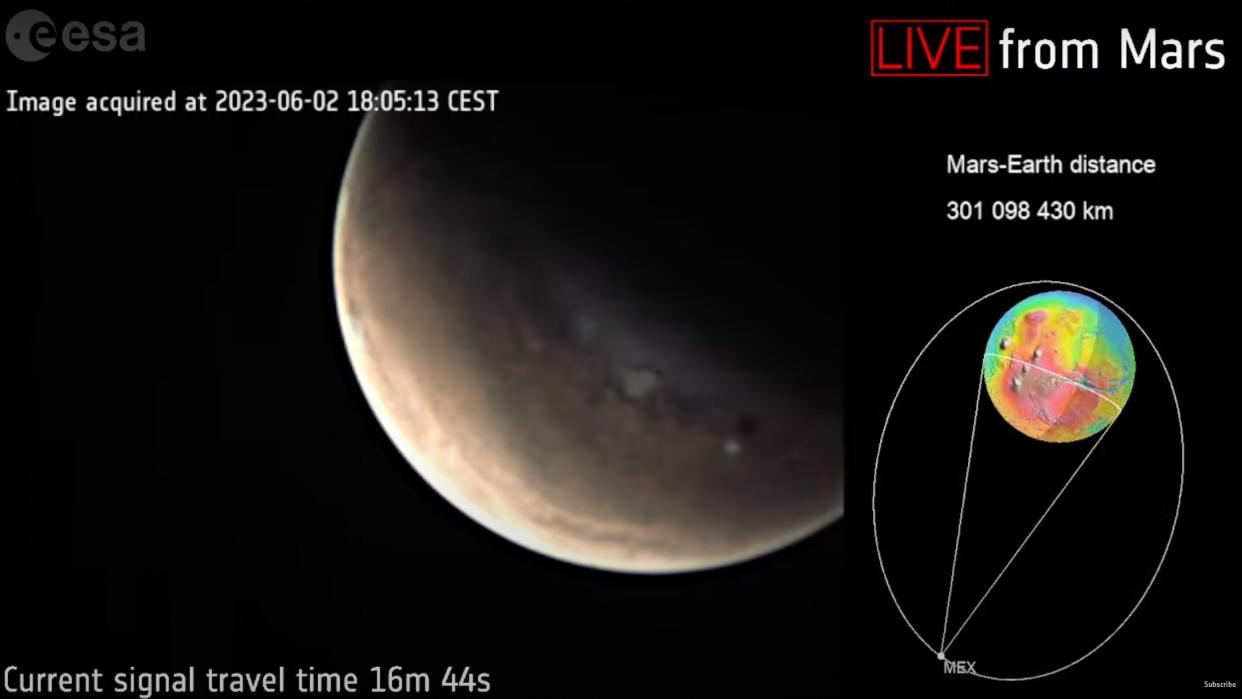Live from Mars! European probe beams Red Planet views to Earth in 1st-ever video feat

The European Space Agency (ESA) celebrated its first Mars probe's 20th launch anniversary in style.
ESA held the first-ever "livestream from Mars" today (June 2), beaming home photos from its Mars Express orbiter in real time — or as close to real time as it's possible to get, given that the Red Planet is currently about 186 million miles (300 million kilometers) from Earth.
That distance translates to nearly 17 light-minutes — meaning it takes that long for communications to travel between Mars Express and mission control here on Earth.
Related: Red Planet photos by Europe's Mars Express spacecraft

The Mars Express team had worked for several months to develop the tools to make today's livestream possible, ESA officials said.
This was new territory — the team was used to processing and releasing images every few days, not live (or close to it) — so there was no guarantee everything would work properly on the unprecedented webcast. But the photos came rolling in right on schedule today.
"Ooh! Here it is! This is the first image from Mars, and it's the most live that you'll ever get, unless you travel to Mars, to the Red Planet itself," a commentator said about seven minutes into ESA's hour-long webcast, which began at noon EDT (1600 GMT) today.
That image, and the ones that followed over the course of the hour, showed a slightly blurry slice of Mars taken by the probe's Visual Monitoring Camera (VMC). Each successive image captured a slightly different view of the planet as Mars Express moved around it.
The VMC was originally designed to be an engineering instrument; its primary job was to document the separation of Europe's Beagle 2 lander, which launched with Mars Express on June 2, 2003.
That separation occurred on schedule in Mars orbit on Christmas Day 2003. Beagle 2 apparently landed safely, but it failed to phone home. Investigators later determined that one or more of the lander's four solar panels likely didn't deploy properly, blocking Beagle 2's communications antenna and dooming it to eternal silence on the Martian surface.
The mission team shut off the VMC shortly after Beagle 2's departure but turned it on again in 2007 to serve as an education and outreach tool. The camera also came to make science observations as well.
"We developed new, more sophisticated methods of operations and image processing, to get better results from the camera, turning it into Mars Express' eighth science instrument," VMC team member Jorge Hernández Bernal said in a statement on Wednesday (May 31).
Related stories:
— Facts about Europe's Mars Express spacecraft
— Mars: Everything you need to know about the Red Planet
— Water on Mars: Exploration and evidence
Mars Express has achieved a great deal with those instruments during its nearly two decades at the Red Planet. For example, the orbiter has sniffed out methane in the thin Martian atmosphere, detected a possible salty lake beneath Mars' south pole and mapped the composition of ice at both of the planet's poles.
"These findings have far-reaching implications," ESA officials wrote in a statement today. "As water is a vital ingredient for the existence of life as we know it, Mars Express has sparked further interest in future missions to the Red Planet, focused on exploring the possibility of past or present microbial life."
Mars Express remains in good health, and its discoveries should keep rolling in: ESA recently extended its mission through at least 2026.

